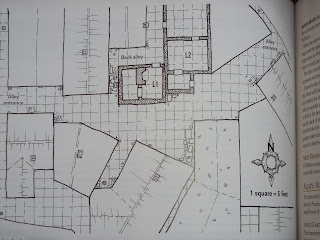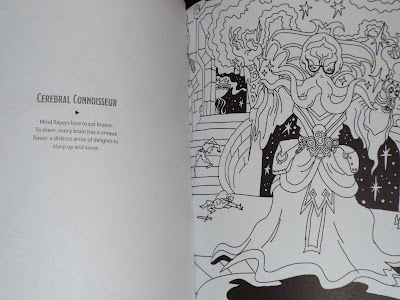Review copy courtesy of Wizards of the Coast.
Pros:
- These are the solid core books of Dungeons & Dragons 5th edition all in one package
- The new covers look fantastic in my opinion. I’m a big fan of the in-game book style of 3rd edition, and the styled covers of these make it look like a book without it’s dust cover.
- It’s the complete core rules and Dungeon Master’s Screen. Roughly 1000 pages of D&D 5e rules goodness.
Could Go Either Way:
- You don’t really need all 3 books to start playing. You can run and have fun with a set of dice (or an online dice roller), the basic rules, and the SRD. However, the extras, especially traps, bonus rules, and monsters are a welcome addition for Dungeon Masters and players like having more options. This isn't the kind of thing to get when you want to get your feet wet, it's the kind of thing you get when you want to go all in.
Cons:
- The books have been around for a while now. That means you can pick up used or discounted copies for cheap. That said, if you can find the set for cheap it’s a good combo, but it’ll be easier to find the older books. I was able to find the set for decent prices, but having to do the research and number crunching is not a plus.
 |
| The contents of the gift set. Nice looking covers if you ask me. They even showed up well on my camera. |
Introduction
It’s
the holidays. Time for family, friends, and rolling saving throws. I
am lucky enough to play D&D during the holidays at least once,
though the big one for my group was always Halloween (rather thematic
I think). However,
Wizards of the
Coast
has recently released
a
core gift set and I'll be looking at it today. It
features the core rules, the previously
release Dungeon
Master Screen,
and a
box to keep it all together.
The Books Themselves
I’ve reviewed all of the books in this set except the Player’s
Handbook. Click on the following links if you want my complete thoughts on
the Monster Manual or Dungeon Master’s Guide. The
short version is that I really liked the Monster
Manual and still do.
My second choice was the
Dungeon Master’s
Guide, and third was
the Player’s
Handbook. It's not that I didn't like the Player's Handbook, but it isn't essential as the basic rules provided enough to play with their 4 basic classes and one archetype each. That said, the extra choices present in the handbook are extremely useful for players to help distinguish their characters. It's also extremely helpful for new players to read.
The creature section of the Player’s Handbook is less useful today than when it was released, because you’ll find the same content in the Monster Manual. And the Monster Manual has a lot of content that is now publicly available in the SRD and the basic rules. However the SRD is art free, only contains stat blocks, and doesn't include everything, but it does include a lot of monsters and one subclass of every class. That makes it extremely useful for the experienced Dungeon Master, but those new to the game will benefit from the lore and fluff provided in the full books. They are good books. Again, for more information check out my full reviews.
The creature section of the Player’s Handbook is less useful today than when it was released, because you’ll find the same content in the Monster Manual. And the Monster Manual has a lot of content that is now publicly available in the SRD and the basic rules. However the SRD is art free, only contains stat blocks, and doesn't include everything, but it does include a lot of monsters and one subclass of every class. That makes it extremely useful for the experienced Dungeon Master, but those new to the game will benefit from the lore and fluff provided in the full books. They are good books. Again, for more information check out my full reviews.
Dungeon Master’s Screen
I never got the screen on
release. I only heard people say it had a lot of wasted space. Well,
now I do. This screen is
alright, but I think many experienced Dungeon
Master’s either make
their own, or add their own notes using sticky notes or clips. I
think the content of the screen is a good start, but I’d add my own
reference sheets to make everything seamless. In
particular I would have liked to see the fatigue and weather rules
included. The
visuals are nice and help make it easier to skim, but I really
would’ve liked to have seen more on it. Now
is it worth 20 dollars? I
mean, that could be spent on miniatures or something.
That’s a harder question. I
could see it being very helpful for a new player, but an experienced
player could make their own quite easily and have it exactly as they
like. Now that I think about it, they probably already have. Even worse, if you mostly play online using Roll20 or
something, you can just have your reference sheets on your desk with
no fear that your players will read it. That
said, I think I will end up using it for my in person games now that
I have one. I’m also
sure you can find it for less. I can see it being an extremely useful boon to a new Dungeon Master. It's worth noting that the limited edition version also has new artwork done in the same style as the book covers.
Covers
The
normal covers are exactly what you expect to get. We've seen them before. The special edition
covers, which are the ones I received, are new and I personally
really like that style. They even changed the cover image for the Dungeon Master's screen. My
favourite cover from this
edition is still Rise of Tiamat.
The art style just works for me on every
level, and I’d like to see
more. In
the normal core books, my favourite is the Monster Manual
but I think I might prefer the black background and stylized art of the
special edition covers. The problem is that whenever I found the limited edition gift sets
online, they cost more. I
guess that’s the limited edition part coming through.
Price
The
MSRP for the set is the same as the MSRP of the individual components put together or
$169.95 USD.
However,
the books have already been around for a while. The
Dungeon Master’s
Guide,
the last released of the core books, came out 4 years ago. This
means you can easily find it online either used, or at a discounted
price from the MSRP. The
good news is that I was also able to find the gift set at reduced
prices as well. This
means you’ll either be paying the same or more for the gift set
than buying the books separately yourself. Or,
worst case, you’ll find it harder to buy the gift set. The
end result is that you need to do some math to determine if buying
the set is the best deal, instead of a no-brainer. Personally
I think this was a missed opportunity.
Conclusion
This
is a collection of the prove D&D 5th
edition core rule books. The
Player’s Handbook,
Monster Manual, and
Dungeon Master’s Guide are
included along with a screen. There
is also a
limited hobby store exclusive version featuring new cover art, which
I think is fantastic. If you
know someone
who loves D&D, it would absolutely make a great gift. Where it
gets complicated is that it’s a pricey item at a $169.95 USD, which
the same price as buying everything individually.
To make matters more
complicated, the individual parts have been already released so it
could be more expensive to buy the set. You’d need to do research
to check prices when you buy, as I was able to find deals where the
non-limited edition gift set cost the same as the
reduced price individual
components. Even at
reduced prices, the
gift set is still expensive
making the D&D 5e starter set (MSRP
19.99
USD) the low price
alternative that’s a much
better fit for people who you aren't sure will enjoy D&D. It even comes with dice, which the gift set doesn't. However, for those who you
know have been dying to get the new core rules it can’t be beat
when found at the right price.











